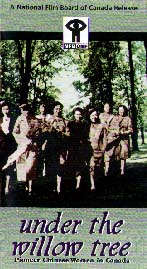|
________________
CM . . . .
Volume V Number 3 . . . . October 2, 1998
Narrator/director Dora Nipp uses pictures from an old trunk and the memories of six Chinese Canadian women to take viewers on a fascinating personal journey into a little known part of our heritage. The experiences of her subjects, all born before World
War II, chronicle the hardships and joys of growing up as part of the Chinese community in Canada. The women speak of families separated by exclusionary immigration laws, the infamous "head tax," disenfranchisement up to 1947, discrimination and restricti
ons which, by today's standards, seem unthinkable. Yet despite these barriers so openly recalled by each of the women interviewed, despite the sorrow and isolation felt by their generation, they speak with a quiet dignity and humour which seems untainted
by bitterness or blame. As well as the many obstacles Chinese women faced as outsiders in Canadian society, they also had to battle against the "dutiful daughter" role and the firmly fixed notion held by many of their community that "Your lot was your l
ot."
Carefully chosen photographs interspersed with the narration bring to life the times and events the women are recalling. Pictures of activities such as picnics, parades, and war-time fund-raising activities give the viewer a sense of the strength and soli
darity of the women of the Chinese community. The importance of the contribution made by these pioneer Chinese women to their daughters' lives is aptly expressed at the end of the video by the Chinese saying: "They planted the tree so we could enjoy the s
hade."
Under the Willow Tree, though well put together and competently narrated, is somewhat over long, and lacks the kind of dramatic force it takes to engage the interests of younger adolescents. Nevertheless it should prove a valuable resource for tea
chers of Canadian studies in the senior years. Suggestions for activities on exploring stereotypes and discrimination and thought-provoking questions are set out in the guide for use before and after screening. Several excellent suggestions for projects
on immigration and family history are included as follow-up ideas to enrich and extend the curriculum. As well, and equally valuable for teachers and librarians engaged in resource-based learning, there is a list of related films and
books (including fiction and poetry) plus a chronology of Chinese history from 1788 to 1967.
Valerie Nielsen is a recently retired Winnipeg teacher-librarian.
To comment on this title or this review, send mail to cm@umanitoba.ca.
Copyright © the Manitoba Library Association.
Reproduction for personal use is permitted only if this copyright notice
is maintained. Any other reproduction is prohibited without
permission.
Published by
TABLE OF CONTENTS FOR THIS ISSUE - OCTOBER 2, 1998.
AUTHORS |
TITLES |
MEDIA REVIEWS |
PROFILES |
BACK ISSUES |
SEARCH |
CMARCHIVE |
HOME
|

